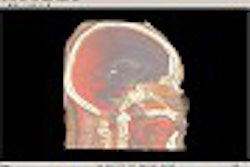The quest to reduce CT radiation dose continues. A group in Boston found that cutting radiation dose in half for routine chest CT studies can still produce images of acceptable quality. Their results are published in this month’s issue of the American Journal of Roentgenology.
Researchers from the Massachusetts General Hospital and Harvard Medical School prospectively studied 24 cancer patients using a multidetector CT scanner (LightSpeed QX/i, GE Medical Systems, Waukesha, WI), reducing the standard dose by 50%.
"Conventional chest CT isusually performed using settings between 220 and 280 mAs," the authors wrote. "Although low- and ultra-low-dose chest CT are used in some institutions, primarily for lung cancer screening, this approach has not received widespread acceptance and practice for routine indications," (AJR, August 2002, Vol.179:2, pp. 461-465).
Each of the patients, who ranged in age from 65 to 81, underwent four-slice MDCT imaging centered at the carina at a standard dose of 220-280 mAs, and again at a reduced dose of 110-140 mAs, with a constant 140 kVp. Scanning was performed in a single breathhold using a 2.5-mm detector configuration, tube rotation time of 0.8 sec, and a pitch of 6:1; contiguous images were then reconstructed at 5-mm intervals, according to the study team.
Blinded to the CT technique, two subspecialty-trained chest radiologists then reviewed randomized images for overall image quality and anatomic detail of lung, airway, mediastinum, and chest-wall structures using a 5-point scale, with 1 representing the worst quality and 5 signifying excellent quality.
The first observer reported mean scores for standard-dose chest scans of 3.66 (patients < 55 kg), 3.67 (55-80 kg), and 3.75 (> 80 kg), while the second observer gave mean scores of 4 (< 55 kg), 3.9 (55-80 kg), and 3.75 (> 80 kg). For reduced-dose CT, the first observer produced mean scores of 3.3 (< 55 kg), 3.14 (55-80 kg), and 3.5 (> 80 kg). The second observer turned in mean scores of 4 (< 55 kg), 3.58 (55-80 kg), and 3.12 (> 80 kg).
"We found that the perceived difference between high- and low-dose CT scans is greater than the perceived variation among patients on the same dose," the authors wrote. "Although the image quality of the standard-dose CT was better than that of low-dose CT across all weight categories, the image quality of low-dose CT was acceptable across all weight categories."
The group cautioned that the sample size was small, and that weight-based reduction of the tube current might have yielded different results. And the study did not evaluate the effect of reduced dose on diagnostic information.
"The diagnostic accuracy of routine low-dose chest CT involving patient populations of diverse weight categories should be assessed," they wrote.
In an accompanying commentary, Dr. Lee Rogers, AJR's editor in chief, wrote that "these researchers present welcome evidence that when it comes to radiation exposure dose, we might well be able to do with less," (AJR, August 2002, Vol.179:2, p. 299).
By Erik L. Ridley
AuntMinnie.com staff writer
August 5, 2002
Related Reading
MDCT protocols boil down to tradeoffs, June 26, 2002
Lowering CT dose yields usable results in renal colic, May 24, 2002
Experts weigh benefits, drawbacks of whole-body CT, May 2, 2002
MDCT imaging delivers higher organ doses than SDCT equivalent, November 27, 2001
Slashing CT dose in clinical practice, July 25, 2001
Copyright © 2002 AuntMinnie.com




















